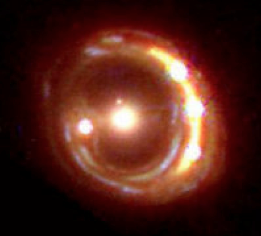My research in strong lensing really started with the discovery and characterisation of the properties of the gravitationally lensed quasar RX J1131-1231 (Sluse et al. 2003, Sluse et al. 2006, Claeskens et al. 2006, Sluse et al. 2007). I discovered that object during the second year of my PhD while I was targeting quasars in order to measure their polarisation. This system turned out to be rather exceptional in the “lensed quasars zoo”: it has a cusp-like configuration, it shows one of the brightest and most structured Einstein ring, and its lensed images are affected by high amplitude microlensing. Soon after its discovery, the COSMOGRAIL collaboration started to monitor this system. The lightcurve over 9 years of monitoring has been recently released (Tewes et al. 2013) and the accurate time delays between the lensed images has been used to derive H0 with 7% precision (Suyu et al. 2013).
In addition to a detailed study of this system, I worked on the characterisation (lens redshift, accurate astrometry, evidence for differential extinction, microlensing) and lens modeling of many other systems. My work consisted in both detailed study of individual systems and statistatical properties of a sample of objects (e.g. Sluse et al. 2008, Chantry, Sluse, Magain 2010, Faure, Sluse et al. 2011, Sluse et al. 2012a).

